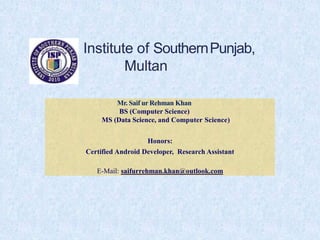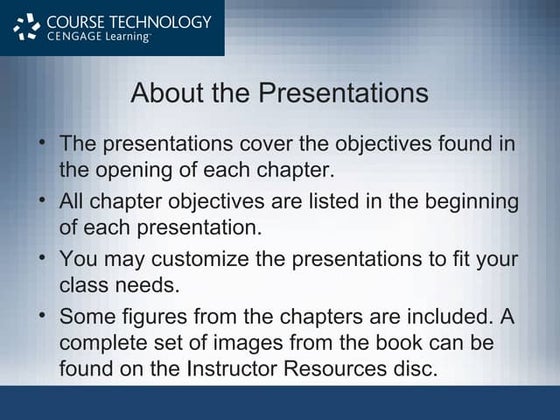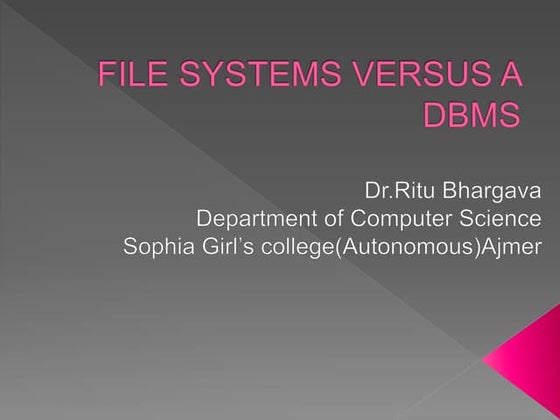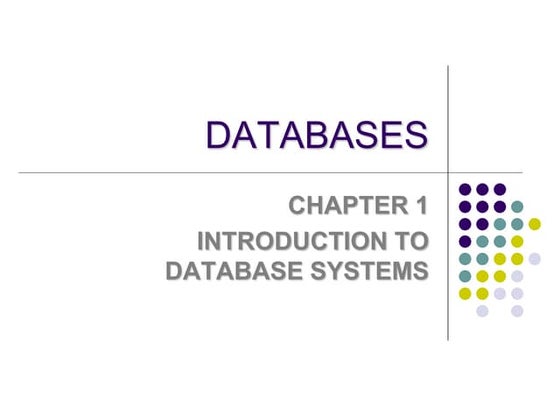Db lecture 1
- 1. Institute of SouthernPunjab, Multan Mr. Saif ur Rehman Khan BS (Computer Science) MS (Data Science, and Computer Science) Honors: Certified Android Developer, Research Assistant E-Mail: saifurrehman.khan@outlook.com
- 2. 2 Database Systems Lecture#1 Introduction to Database
- 3. Course- Objectives ï― Introduce basic database concepts. ï― Data Storage & retrieval techniques. ï― Database Design. ï― Different data models. 3
- 4. Course Primarily- Objectives ï― Relational data model. ï― Database Management System (DBMS) concepts. 4
- 5. Chapter 1 - Objectives ï― Some common uses of database systems. ï― Characteristics of file-based systems. ï― Problems with file-based approach. ï― Meaning of the term database. ï― Meaning of the term Database Management System (DBMS). 5
- 6. Chapter 1 - Objectives ï― Typical functions of a DBMS. ï― Major components of the DBMS environment. ï― History of the development of DBMS. ï― Advantages and disadvantages of DBMS. 6
- 7. Examples of Database Applications ï― Purchases from the supermarket ï― Purchases using your credit card ï― Booking a holiday at the travel agents ï― Using the local library ï― Taking out insurance ï― Renting a video ï― Using the Internet ï― Studying at university 7
- 8. History: ï― Computers initially used for computational / engineering process. ï― After some time it has been thought that why should not used computer for commercial application. So in this way some languages were being used for such purpose like COBOL language. ï― Commercial application introduced File Processing System. 8
- 9. File-Based Systems ï― Collection of application programs that perform services for the end users (e.g. reports). ï― Each program defines and manages its own data. 9
- 10. File-Based Systems ï― Each system maintain data and processing its own. ï― Each system has own data and program/application. Each system store there own data separately and process independently. ï― Each system have own program for the purpose of processing (Read / Store / Minor Calculation / output on the screen). ï― In each system program and data are interdependence because program and data are depended on one another. 10
- 12. Limitations of File-Based Approach ï― Program-Data Dependence ï― All programs maintain metadata for each file they use ï― Duplication of Data ï― Different systems/programs have separate copies of the same data ï― Limited Data Sharing ï― No centralized control of data ï― Lengthy Development Times ï― Programmers must design their own file formats ï― Excessive Program Maintenance ï― 80% of information systems budget 12
- 13. Limitations of File-Based Approach ï― Incompatible file formats ï― Programs are written in different languages, and so cannot easily access each otherâs files. ï― Fixed Queries of application programs ï― Programs are written to satisfy particular functions. ï― Any new requirement needs a new program. 13
- 14. Problems with Data Dependency ï― Each application programmer must maintain his/her own data ï― Each application program needs to include code for the meta data of each file ï― Each application program must have its own processing routines for reading, inserting, updating, and deleting data ï― Lack of coordination and central control ï― Non-standard file formats 14
- 15. 15
- 16. Problems with Data Dependency ï― If data is being changed then the program must be changed and vice versa For example if a library system has some attributes about book like. ï― Book_id ï― Book_name ï― Book_title ï― Book_author And after some time we add an other attribute like book_edition. So you need to change data but on other hand you have to change the program as well because program is dependent on data and vice versa It means that if you change the data in library system you will have to change Examination and Registration systems. 16
- 17. Figure 1-3 Old file processing systems at Pine Valley Furniture Company Duplicate Data 17
- 18. Problems with Data Redundancy ï― Waste of space to have duplicate data ï― Causes more maintenance issues The biggest problem: ï― Data changes in one file could cause inconsistencies ï― Compromises in data integrity 18
- 20. No data sharing concept and inconsistency ï― Attribute Address appears in two systems, Examination and Registration. (Duplication) ï― It creates inconsistency ï― for example if a student changes his address in registration system and not updated examination ï― Address of student is different for registration information communication and examination information communication. 20
- 22. Definitions ï― Database: ï― A database is a shared collection of logically related data, which is stored to meet the requirement of different users of an organization. ï― Data: Raw facts about any thing. ï― stored representations of meaningful objects and events ï― Structured: numbers, text, dates ï― Unstructured: images, video, documents 22
- 23. Definition1 ï― Logically related data: for example a man is working in a company and we want to get facts/data about such worker. We can gather many data like ï― Necessary Data ï― Name ï― FName ï― Address ï― So manyâĶ. ï― Unnecessary Data ï― Size of shoe ï― Hair color ï― Height ï― Weight ï― So manyâĶ. 23
- 24. Definition1 ï― Shared Collection: There are some data that is common for different systems. Such data must not be duplicated and that should be shared 25
- 25. Definition 2: ï― A database is a self describing collection of integrated records. ï― Self describing: ï― In database, there are not only data stored but also structure/definition/checks of that data. (In DBMS it is called Schema/meta data. We will see later in more detail) ï― Meta data is the part of database 26
- 26. Definition 2: ï― Integrated record: ï― Records are linked to one another ï― When you see a record, to understand full meaning of that record you will have to consider another record. ï― It means that for understanding of a record you need another record which is linked with it. 27
- 27. Definitions ï― Information: data processed to increase knowledge of the person using the data. ï― The processed data is called information (adding some knowledge). ï― Process means to add something to data. ï― To name/ label data is also a process. ï― Process can also add some knowledge, some information to the data. 28
- 28. Graphical displays turn data into useful information that managers can use for decision making and interpretation Figure 1-1b Summarized data 30
- 29. Descriptions of the properties or characteristics of the data, including data types, field sizes, allowable values, and data context 31
- 30. The DATABASE Approach ï― Data sharing (common data is being stored at one place rather than storing the same on separate terminals) ï― Data independence: Both data and program are now independent, if you change data in one system, only that system will require the change. ï― Controlled Redundancy (Duplication) ï― Better Data Integrity ï― Data consistency ï― Better data security 32
- 31. ï― Control of data redundancy ï― Data & resource sharing eliminates or at least minimize duplication ï― Better concurrency control ï― Multiple users access the data at the same time e.g. ATM ï― Better Backup and Recovery procedure The DATABASE Approach 33
- 33. Database Management System DBMS manages data resources like an operating system manages hardware resources ïŊ A software system that is used to create, maintain, and provide controlled access to user databases Order Filing System Invoicing System Payroll System DBMS Central database Contains employee, order, inventory, pricing, and customer data 35
- 34. Database Management System ï― (Database) application program: a computer program that interacts with database by issuing an appropriate request (SQL statement) to the DBMS. 36
- 35. Database Approach: Parts of DB ï― Data Retrieval ï― Data Manipulation Language (DML). ï― Transaction Processing (TP) ï― Data definition language (DDL). ï― Data Control Language (DCL). 37
- 36. Views ï― Allows each user to have his or her own view of the database. ï― A view is essentially some subset of the database. 38
- 37. Views - Benefits ï― Reduce complexity ï― Provide a level of security ï― Provide a mechanism to customize the appearance of the database ï― Present a consistent, unchanging picture of the structure of the database, even if the underlying database is changed 39
- 38. Components of DBMS Environment 40
- 39. Components of DBMS Environment ï― Hardware ï― Can range from a PC to a network of computers. ï― Software ï― DBMS, operating system, network software (if necessary) and also the application programs. ï― Data ï― Used by the organization and a description of this data called the schema. 41
- 40. Components of DBMS Environment ï― Procedures ï― Instructions and rules that should be applied to the design and use of the database and DBMS. ï― People 42
- 41. Roles in the Database Environment ï― Data Administrator (DA) ï― Database Administrator (DBA) ï― Database Designers (Logical and Physical) ï― Application Programmers ï― End Users (naive and sophisticated) 43
- 42. History of Database Systems ï― First-generation ï― Hierarchical and Network ï― Second generation ï― Relational ï― Third generation ï― Object-Relational ï― Object-Oriented 44
- 43. Advantages of DBMSs ï― Control of data redundancy ï― Data consistency ï― More information from the same amount of data ï― Sharing of data ï― Improved data integrity ï― Improved security ï― Enforcement of standards ï― Economy of scale 45
- 44. Advantages of DBMS ï― Balance conflicting requirements ï― Improved data accessibility and responsiveness ï― Increased productivity ï― Improved maintenance through data independence ï― Increased concurrency ï― Improved backup and recovery services 46
- 45. Disadvantages of DBMSs ï― Complexity ï― Size ï― Cost of DBMS ï― Additional hardware costs ï― Cost of conversion ï― Performance ï― Higher impact of a failure 47
- 46. Summary of Lecture ï― Some common uses of database systems. ï― Characteristics of file-based systems. ï― Problems with file-based approach. ï― Meaning of the term database. ï― Meaning of the term Database Management System (DBMS). 48
- 47. Summary of Lecture ï― Typical functions of a DBMS. ï― Major components of the DBMS environment. ï― History of the development of DBMS. ï― Advantages and disadvantages of DBMS. 49
- 48. 50 END OF LECTURE 01
Editor's Notes
- #9: Commercial application means no maximum calculation / computation involve. Only data processing (Read/store/minor calculation) and then get output either on Monitor or paper.
- #13: Metadata summarizes basic information about data, which can make finding and working with particular instances of data easier. For example,Ėýauthor,ĖýdateĖýcreatedĖýandĖýdate modified andĖýfile sizeĖýare examples of very basic document metadata. ĖýHaving the ability to filter through that metadata makes it much easier for someone to locate a specific document











































































![Data Models [DATABASE SYSTEMS: Design, Implementation, and Management]](https://cdn.slidesharecdn.com/ss_thumbnails/coronelpptch02-datamodels-190903105908-thumbnail.jpg?width=560&fit=bounds)








































